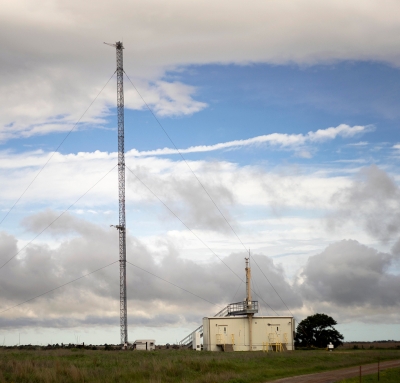The Truth About Shallow Clouds: Science Goes Airborne in Oklahoma
Published: 18 April 2016
ARM-funded campaign to understand the life cycle of shallow clouds and improve climate modeling

Starting in late April, and then again in August, researchers will conduct two separate month-long periods of intensive observation to gather detailed measurements of processes affecting the life cycle of shallow cumulus clouds.
Why Cumulus?
These common fair-weather clouds reflect the sun’s energy back into space and, under the right conditions, can grow to form storm clouds and ultimately rain. Cumulus convection, or upwelling and mixing, plays a key role in the atmospheric radiation budget and hydrologic cycle over the Southern Great Plains and many other regions of the world, particularly during the summer growing season when surface fluxes of heat, moisture, and momentum control turbulent quantities in the daytime boundary layer up to the base of clouds. Despite their importance, the small size of shallow clouds has made them difficult to study—until now.
Holistic Interactions of Shallow Clouds, Aerosols, and Land-Ecosystems, or HI-SCALE, is a new campaign designed to provide detailed scientific data about the linked processes that govern these cotton-ball-like clouds. Extensive aerial measurements will complement observations from the Atmospheric Radiation Measurement (ARM) Climate Research Facility’s Southern Great Plains (SGP) megasite in Oklahoma. Data will also be used to validate large-eddy simulations (LES) and cloud-resolving models that provide more pieces of the shallow cloud puzzle.
Jerome Fast of Pacific Northwest National Laboratory, principal investigator for HI-SCALE, is optimistic about the upcoming campaign. “We’re trying to accomplish a lot this spring and summer,” he says, “because we need to measure a wide range of quantities to advance our understanding of shallow clouds.”
HI-SCALE and the ARM Facility are funded by the U.S. Department of Energy to provide critical, fine-resolution data that will help improve computer models that simulate Earth’s climate. Better models, in turn, should ultimately improve weather forecasts, climate prediction, water resources management, and food production.
Land Use Affects Cloud Formation

The surface of the land is a complex mosaic of vegetation types, ecosystems, and human use regimes. All of these factors influence weather, and the behavior of clouds plays a big part in that equation. Airborne and ground-based observations from HI-SCALE will help scientists quantify the influence of differences in land use, vegetation, soil moisture, turbulence within convective eddies, and the properties of aerosols (tiny suspended particles or droplets from natural or human sources) on the formation, growth, and dissipation of clouds near the Earth’s surface. HI-SCALE’s two observation periods take advantage of different stages and distribution of “greenness” for various types of vegetation near the SGP megasite, as well as organic aerosol properties that vary during the growing season.
- improve parameters for land-atmospheric interactions and shallow clouds for next-generation climate models, and
- evaluate model predictions of cloud attributes such as heat fluxes, moisture and momentum, turbulence in the boundary layer (the lowest 2k of the atmosphere), microphysics, and aerosol properties.
“In a nutshell,” Fast explains, “we’re trying to uncover the secret life of clouds.”
It’s All About Instrumentation

HI-SCALE will rely on the ARM Aerial Facility’s Gulfstream-159 (G-1) aircraft, as well as ground instrumentation at the SGP megasite, which is deliberately situated at the meteorological ‘four corners’ of the site. The G-1 will fly transects over the site at several altitudes within the boundary layer, inside clouds, and above clouds. The array of technology on the G-1 includes:
- high-frequency meteorological and radiation instruments to measure heat fluxes
- cloud probes that characterize microphysical properties such as droplet size distribution and liquid water content
- trace gas monitors to help differentiate between urban, industrial, agricultural, and other air masses
- a suite of six spectrometers to identify organic compounds and aerosol composition, particle size, and distribution
- particle counters to quantify total aerosol number concentration
- a Dual-Cloud Condensation Nucleus Chamber to measure concentrations of the kernels around which raindrops form.
The SGP megasite itself is equipped with over 50 constantly operating measurement systems. These instruments also take measurements to study clouds, aerosols, precipitation, and solar and thermal energy. Data are provided free of charge online to scientists worldwide.
Fast notes, “HI-SCALE’s differentiator is that we’ll be simultaneously studying multiple facets of the initiation and evolution of shallow clouds, and then assembling our data sets to obtain an improved understanding of the interactions of the land and atmosphere that need to be represented by models. While progress has been made by previous research programs that studied individual processes affecting clouds, they weren’t integrated. HI-SCALE also aims to yield new insights about why shallow clouds transition to deep convection.”
Follow HI-SCALE along on the Field Notes blog.
# # #
The ARM Climate Research Facility is a national scientific user facility funded through the U.S. Department of Energy’s Office of Science. The ARM Facility is operated by nine Department of Energy national laboratories, including the Pacific Northwest National Laboratory, which leads management of the ARM Aerial Facility, and Argonne National Laboratory, which manages ARM’s Southern Great Plains megasite.
The ARM Climate Research Facility is a DOE Office of Science user facility. The ARM Facility is operated by nine DOE national laboratories, including .
Keep up with the Atmospheric Observer
Updates on ARM news, events, and opportunities delivered to your inbox
ARM User Profile
ARM welcomes users from all institutions and nations. A free ARM user account is needed to access ARM data.


















